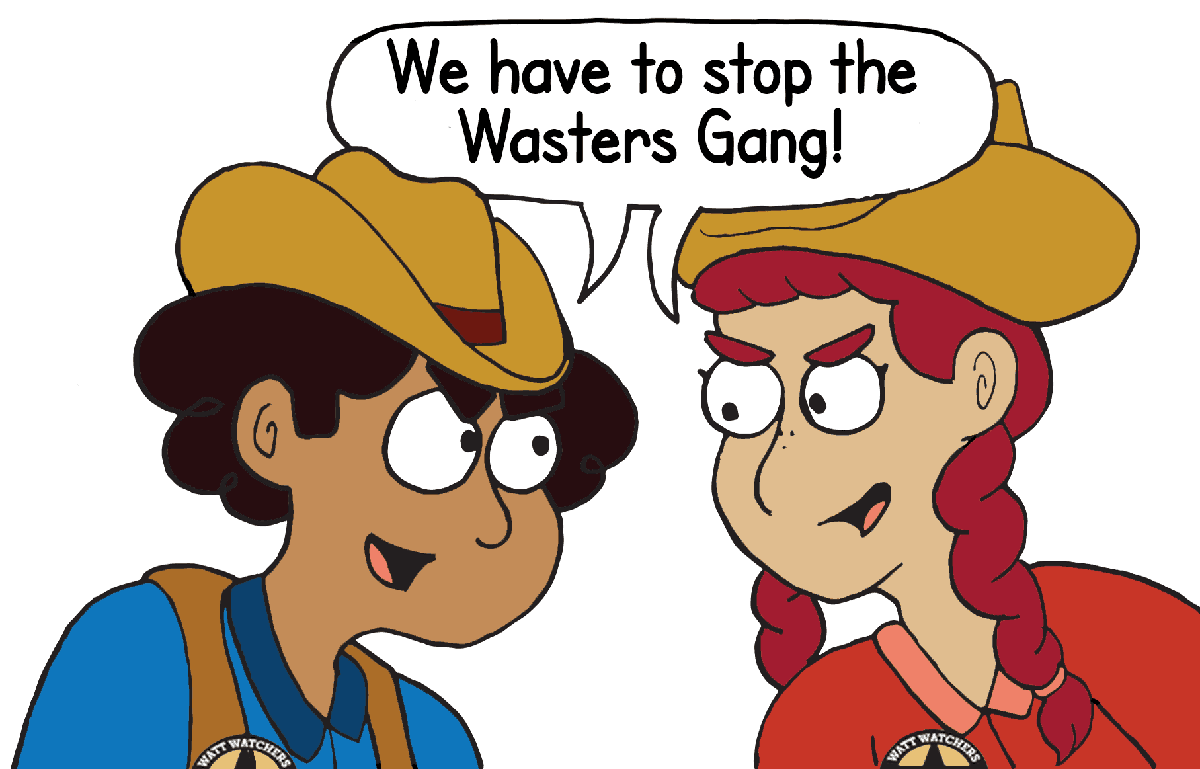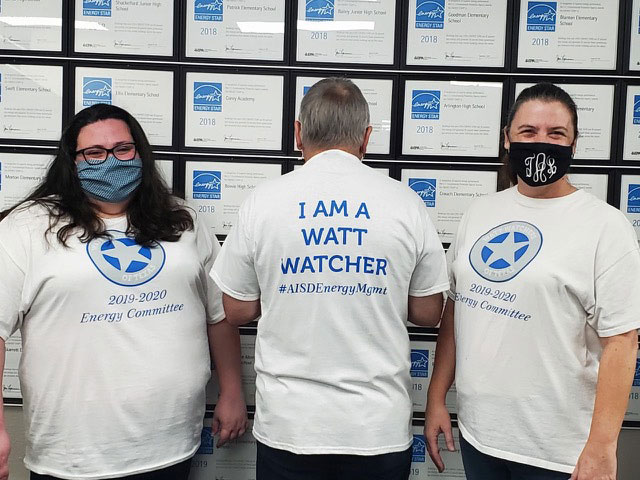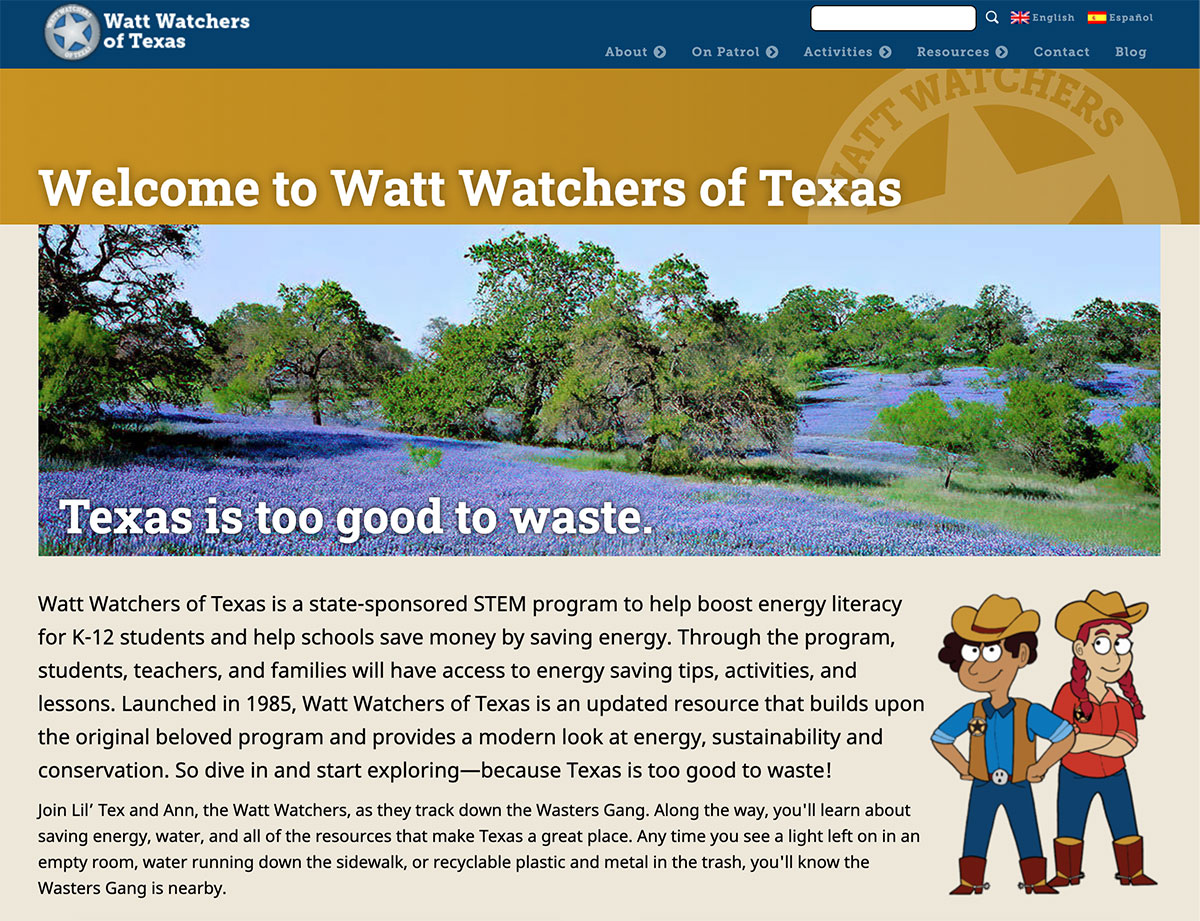Students from the Pflugerville Independent School District go on an energy patrol in 2018. Courtesy of Pflugerville ISD.
All across America, school is back in session. For some, that means desks, dry erase boards, recess and books. For others, it’s taking a decidedly more virtual approach. But no matter the form it takes, young learners are activating their brains to new ideas through lessons and activities.
One of the hallmarks of learning in Texas is the Watt Watchers of Texas, an educational program centered around energy efficiency and conservation. For 35 years, Watt Watchers’ lessons and activities have educated thousands of Texas students on the benefits of saving energy, while saving their school districts and families thousands of dollars on energy bills in the process.
With a track record of educating about smarter energy practices and having a lasting effect on students and districts, we went behind the scenes with Watt Watchers program manager Juan Garcia and Dr. Michael E. Webber, principal investigator from The University of Texas at Austin, to learn about the program’s history, its growth and its future.
Energy Patrols & Education: A Brief History
Launched as a pilot program in 1985 by a cooperative of 50 school districts in eastern Texas, the original Watt Watchers of Texas program centered around students serving as “energy monitors” for their schools. This involved students patrolling areas throughout their building to look for energy waste in the form of turned-on lights and equipment in empty rooms. If a student monitor discovered such a room, he or she would shut off the lights, log the offending room and leave behind a paper “ticket” alerting occupants to the impact of wasted energy.
Within the first year of the pilot, students helped the Galveston Independent School District save $25,000 in electricity costs. Following strong initial success, Watt Watchers expanded to West Texas school districts through a partnership with the University of Texas Permian Basin and then grew to serve 160 school districts in 1993. By 2005, more than 550 districts and nearly 3,200 teachers enrolled in the program to engage their students and help conserve energy.
Video courtesy Pflugerville ISD Energy Management
According to Garcia, much of the early success of the program was attributable to its flexibility, using developed lessons and guides as needed to fit their school’s energy needs. Some districts created incentivization programs and challenges for classrooms, while others leveraged the program as part of science and responsibility curricula.
Over time, Watt Watchers of Texas expanded to include lessons on preventing pollution and stopping other forms of energy waste, even as students continued watching watts, ticketing teachers and helping save their school districts and families thousands on their energy bills.
In 2018, the Texas State Energy Conservation Office partnered with energy expert Dr. Webber and his team at the University of Texas at Austin and Disco Learning Media to revamp Watt Watchers of Texas into a digital-first educational program and portal. “Today, Watt Watchers goes deeper than just turning the lights off: students, teachers and families can learn about energy conservation and cost saving tips through modern topics such as food, water, and transportation,” Garcia said.
Watt Watchers Goes Digital
Bringing a program like Watt Watchers with a legacy of pen and paper activities and on-site lessons into a digital format was a massive undertaking, made more complicated by the fact that Watt Watchers’ organizing groups/owners had changed multiple times over the decades.
“[Our teams] reviewed three decades of archives and legacy materials. This was a lengthy, six-month process,” Dr. Webber told us. “However, since many lessons and activities were [very much of their time]—our favorite was ‘How to calibrate your water bed’—the team opted to create new lessons from scratch.”
Modifying, remaking and generating new, education standards-aligned lessons from the ground-up took the team another six months of dedicated work, which happened in phases alongside the development and launch of the new Watt Watchers website in 2018. By the end of 2019, the team had created more than 120 new, free lessons and activities for students ranging from kindergarten to twelfth grade.

Organizers even created a new storyline for the program to help engage younger students. Centered around a pair of young energy-conserving cowpokes named Lil’ Tex and Ann, students are encouraged to track down and stop the “Wasters Gang” from wasting unnecessary electricity. Educators can leverage custom-made activity sheets and downloadable artwork to help flesh out program implementation.
Garcia says the new platform has already proven invaluable from an update perspective, allowing the Watt Watchers team to publish lessons and activities to the site as they’re ready rather than wait for future semester or school year.
Going digital has increased the value for districts as well.
“Arlington ISD has found the Watt Watchers of Texas program a fantastic, immersive experience that provides our district with all of the support needed to help boost energy literacy for K-12 students and help [our] schools save money by saving energy,” Danny Helm, an Energy Manager from the Arlington Independent School District told us. “The Watt Watchers program has provided [us with] an enormous opportunity for our energy savings.”
Watt Watchers’ pivot to digital has also proved critical as schools and families adjust to different forms of learning as a result of coronavirus.

Photo courtesy Arlington ISD Energy Management
Well Positioned for Pandemic Learning
While Watt Watchers of Texas prides itself on its core patrolling and energy monitoring activities as a form of hands-on learning, the program’s expansion into digital resources have made it easy for educators and families to keep young learners engaged.
In addition to wide availability of the program’s lessons and resources, the team developed a “Watt Watchers At-Home” curriculum, focused even more closely on home-based activities that can be facilitated by educators through virtual learning or by parents. Students can even go on home patrols to reduce energy waste in their residence.
“Everyone loves that all of the lessons are ready to go in English and Spanish, and this is even more important as our students learn remotely,” shared Ashley Williams, C.E.M. Energy Conservation Engagement Coordinator at the Austin Independent School District. “The team was quick to respond to the pandemic with their ‘At Home’ section, and continues to evolve with our situation.”

Outside of providing lessons and activities for students, Dr. Webber told us that Watt Watchers’ ongoing support for educators remains key. The team offers educator training sessions and workshops thanks to partnerships with KLRN PBS San Antonio and the National Wildlife Federation’s Eco Schools USA program, as well as regular updates via email.
“[We continue] to connect with districts, teachers, and energy managers to encourage program adoption and usage,” Dr. Webber said. “While many schools are doing virtual learning during the fall semester, we’re hopeful that when students and teachers return to campus, they’ll be prepared and ready to roll out Watt Watchers at their school or district.”
What’s Next for Watt Watchers
Even with more than 120 free lessons and activities for students available digitally, the Watt Watchers team believes it has plenty to do. In the coming months, they plan to continue creating additional lessons and advocating for energy education among Texas schools.
The lesson library, recently translated into Spanish thanks to program sponsors, has even drawn interest from other states and districts looking to adapt it for their own schools. While no formal plans exist yet, Garcia and Dr. Webber told us that they’re exploring a national expansion of Watt Watchers in the coming years. Until then, all Watt Watchers lessons and resources remain free for educators and parents to access, use and modify as needed.
Getting Started with Watt Watchers
Teachers and parents can access all Watt Watchers lessons and resources at watt-watchers.com. A program guide for teachers, with information on starting in-person patrols as well as digital activities is available online. Get in touch with the Watt Watchers team here.
